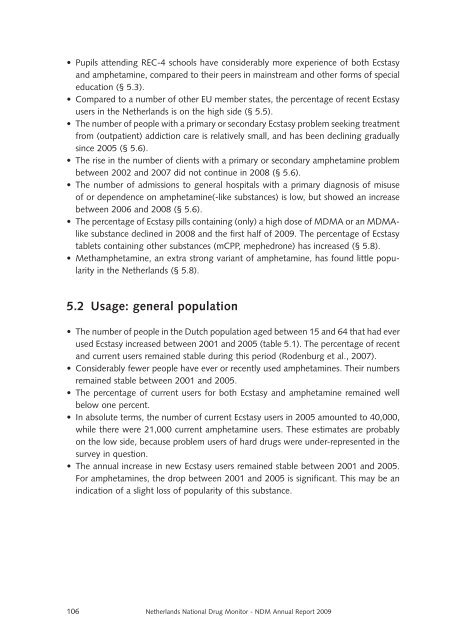Netherlands National Drug Monitor - Research and Documentation ...
Netherlands National Drug Monitor - Research and Documentation ...
Netherlands National Drug Monitor - Research and Documentation ...
You also want an ePaper? Increase the reach of your titles
YUMPU automatically turns print PDFs into web optimized ePapers that Google loves.
• Pupils attending REC-4 schools have considerably more experience of both Ecstasy<br />
<strong>and</strong> amphetamine, compared to their peers in mainstream <strong>and</strong> other forms of special<br />
education (§ 5.3).<br />
• Compared to a number of other EU member states, the percentage of recent Ecstasy<br />
users in the <strong>Netherl<strong>and</strong>s</strong> is on the high side (§ 5.5).<br />
• The number of people with a primary or secondary Ecstasy problem seeking treatment<br />
from (outpatient) addiction care is relatively small, <strong>and</strong> has been declining gradually<br />
since 2005 (§ 5.6).<br />
• The rise in the number of clients with a primary or secondary amphetamine problem<br />
between 2002 <strong>and</strong> 2007 did not continue in 2008 (§ 5.6).<br />
• The number of admissions to general hospitals with a primary diagnosis of misuse<br />
of or dependence on amphetamine(-like substances) is low, but showed an increase<br />
between 2006 <strong>and</strong> 2008 (§ 5.6).<br />
• The percentage of Ecstasy pills containing (only) a high dose of MDMA or an MDMAlike<br />
substance declined in 2008 <strong>and</strong> the first half of 2009. The percentage of Ecstasy<br />
tablets containing other substances (mCPP, mephedrone) has increased (§ 5.8).<br />
• Methamphetamine, an extra strong variant of amphetamine, has found little popularity<br />
in the <strong>Netherl<strong>and</strong>s</strong> (§ 5.8).<br />
5.2 Usage: general population<br />
• The number of people in the Dutch population aged between 15 <strong>and</strong> 64 that had ever<br />
used Ecstasy increased between 2001 <strong>and</strong> 2005 (table 5.1). The percentage of recent<br />
<strong>and</strong> current users remained stable during this period (Rodenburg et al., 2007).<br />
• Considerably fewer people have ever or recently used amphetamines. Their numbers<br />
remained stable between 2001 <strong>and</strong> 2005.<br />
• The percentage of current users for both Ecstasy <strong>and</strong> amphetamine remained well<br />
below one percent.<br />
• In absolute terms, the number of current Ecstasy users in 2005 amounted to 40,000,<br />
while there were 21,000 current amphetamine users. These estimates are probably<br />
on the low side, because problem users of hard drugs were under-represented in the<br />
survey in question.<br />
• The annual increase in new Ecstasy users remained stable between 2001 <strong>and</strong> 2005.<br />
For amphetamines, the drop between 2001 <strong>and</strong> 2005 is significant. This may be an<br />
indication of a slight loss of popularity of this substance.<br />
106 <strong>Netherl<strong>and</strong>s</strong> <strong>National</strong> <strong>Drug</strong> <strong>Monitor</strong> - NDM Annual Report 2009




